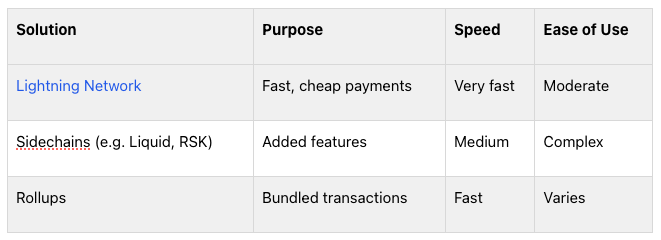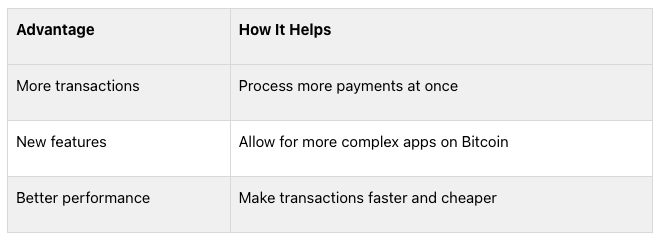Share this article
Bitcoin Layer 2 solutions are built on top of the main Bitcoin network to address its limitations:
- Speed up transactions
- Lower fees
- Enable more features and apps
Key Layer 2 solutions:


Benefits:
- Process more transactions per second
- Reduce congestion on main Bitcoin network
- Enable smart contracts and DeFi on Bitcoin
Challenges:
- Some solutions are centralized
- Can be complex for users
- Security and interoperability concerns
As Layer 2 solutions evolve, they aim to make Bitcoin faster, cheaper, and more versatile for everyday use while maintaining its core principles.
Bitcoin‘s Main Problems
Slow Transactions
Bitcoin has limits on how fast it can process transactions:
- About 5 transactions per second
- Block size: 1-4 MB (usually around 2 MB)
- Block time: 10 minutes
These limits help:
- Keep the blockchain from growing too big
- Stop spam attacks
But they also cause problems for users.
Long Wait Times and Small Blocks


Users often have to wait a long time for their transactions to go through.
Network Jams and High Fees
When lots of people use Bitcoin at once:
- Transactions pile up
- Network gets slow
- Fees go up


This makes Bitcoin expensive to use when it’s busy.
Basics of Bitcoin Layer 2 Solutions
What They Are
Bitcoin Layer 2 solutions are extra systems built on top of the main Bitcoin network. They help Bitcoin work better and handle more transactions.
How They Work
Layer 2 solutions move some transactions off the main Bitcoin network. This helps:
- Reduce network traffic
- Speed up transactions
- Lower fees
These solutions use special contracts to keep transactions safe. They then send the final results back to the main Bitcoin network.
Main Advantages
Layer 2 solutions offer three key benefits:


Make transactions faster and cheaper
These improvements help Bitcoin handle more users and different types of apps without changing its core system.
Types of Layer 2 Solutions
State Channels
State channels are Layer 2 solutions that let two parties make many transactions without recording each one on the Bitcoin blockchain. They work by:
- Creating a private channel between two users
- Allowing fast, cheap transactions off the main chain
- Only recording the start and end of the channel on Bitcoin
Benefits and drawbacks of state channels:


Sidechains
Sidechains are separate blockchains…
Click Here to Read the Full Original Article at Education Archives – Crypto Briefing…
























